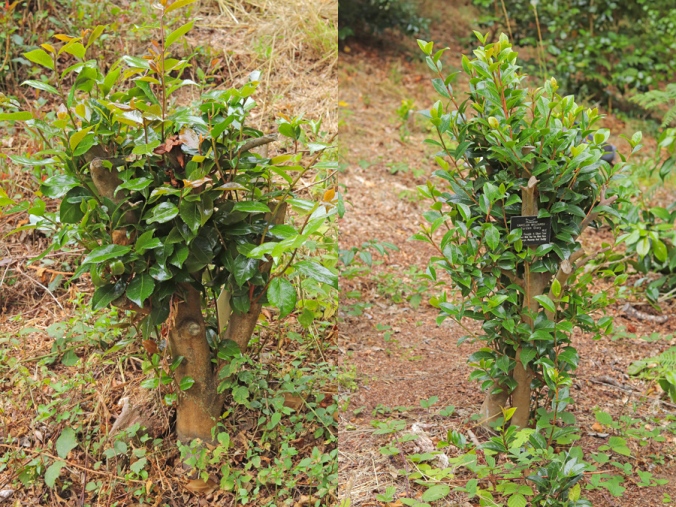Sometime around mid July last year a very large beech tree came down in section 1L, making a mess of a number of the camellias in the section. It was several weeks before the tree was completely cleared and the damage could be properly assessed. At that time I noted that 8 were damaged but would recover, 2 were very badly damaged, necessitating their being cut down to about 2 ft and three had been broken off at ground level.

The split trunk to the right is what remains of the tree that fell across section 1L, covering all of the bare soil area with its branches.
Not expecting the last three to recover, and their being no sign of them doing so by the winter, a plant from another section that was struggling in waterlogged ground, was moved and planted alongside the spot where ‘Strawberry Parfait’ (1L-043) had been.
By the end of 2017 all of the damaged plants had started to shoot and this continued strongly throughout 2018. The plant that was moved in, ‘Turandot’, succumbed to the drought, but astonishingly, ‘Strawberry Parfait’ decided to make a comeback. It is now growing strongly. ‘Little Man’ (1L-022) was also razed to the ground and has started to grow again.

‘Little Man’ on 21 June & 7 August 2018
The two plants that were cut to two feet were ‘Kramer’s Beauty’ (1L-019) and ‘Garden Glory’ (1L-011). The regrowth on both is impressive and they look set to make a full recovery.

‘Kramer’s Beauty’ & ‘Garden Glory’ by 7 August 2018
The third of the ground level plants was another ‘Little Man’ (1L-021) and when I looked at it a few weeks ago there was no sign of growth. This was disappointing and somewhat surprising as there was some indication on the jagged six inch stump that callusing had been taking place. On Tuesday this week, roughly 14 months after the original devastation, I spotted green shoots emerging. Still less than half an inch high, they will need protecting if the plant is to recover. Hard things to kill, Camellias.




Amazing, congrats.
LikeLiked by 1 person
Camellias are wonderful plants as we know! Now we see how tough!
What strikes me about these comebacks is that they have lots of good light & even possibly sunlight—— in contrast I have a Camellia ‘Shiro-kingyoba-wabisuke’ which looks as if it is dead after our neighbouring farmer limed the field next door, but it has not regenerated after a move before it became closer to death to a non-limey patch —perhaps because it is too dark and shady there by a hedge & large Bramley Apple tree. But after this story at MT E, I will give it another winter as it could still shoot from the base.
LikeLike
I doubt whether lime would kill a camellia quickly, I’d expect years of chlorosis and misery but not death.
LikeLike
Yes it has been dying slowly and miserably over about 5 years.Full history now necessary!
It last flowered in 2016 and I moved it to its present dark but lime-free abode in 2017 as the chlorosis did not improve whatever I did in terms of feed –even Sequestrene etc.
I had nitially washed the leaves when the lime fell on it but I also moved it 2-3 feet forwards –when I thought it had escaped the problem– as it had outgrown its space– but clearly the soil is now seriously polluted there and it then started to sicken:I should have moved it earlier and not just moved it forward anyway, but hindsight is a wonderful thing.
LikeLike
That’s probably not going to be easy to find a replacement plant for. Do you want me to try and get some cuttings?
LikeLike
That would be utterly fabulous as I loved it! It flowered very well & was an easy camellia to grow.
You are very kind.
LikeLike
PS Were/Are there any Sasanquas flowering at Mount Edgecumbe? In Devon, I have Sparkling Burgundy & C. sinensis out at least 2 weeks before their earliest previous flowering dates!
LikeLike
Nothing flowering yet. When I went round on Tuesday I looked quite closely but didn’t even see anything showing colour. As soon as I see flowers, I’ll post pictures.
LikeLike